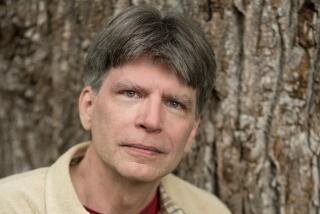How Imagination Shapes Two Destinies
Richard Powersâ seventh novel is the story of two empty rooms, one in Seattle, one in Beirut. Each is as small as a walk-in closet and as vast as the universe. The human imagination alone can fill them--but at what cost?
In the late 1980s, a New York artist, Adie Klarpol, is recruited by an old college friend, Steve Spiegel, to work in âthe Cavern,â a pioneering virtual-reality lab. Adie is willing to move west because she has already fled the âcommercialismâ of avant-garde painting for the honest âcommerceâ of illustration. Why not be paid better for it?
âYou have no idea how horrible it is,â she tells Steve. âTo give your life to a thing you think represents the best that humanity can do, only to discover that itâs not about beauty at all. Itâs about coercion and manipulation and power politics and market share and the maintenance of class relations.â Art is just another commodity.
Adie gradually recovers her idealism in the company of the Cavernâs staff of brilliant eccentrics, and in the sheer pleasure of playing with ever-higher technology. The little white room, whose walls, floor and ceiling are all screens, can become anything she wants--a childlike âCrayon World,â a jungle, Van Goghâs bedroom in Arles, a life-size, fully detailed Byzantine cathedral.
Meanwhile, Taimur Martin, an Iowan whose mother was Iranian, takes a job teaching English in Lebanonâs war-torn capital. His life in America has been dull, and he feels invulnerable. However, a joke he makes in class leads somebody to think heâs a CIA agent. Islamic terrorists kidnap him, chain him to a radiator in the second little room, feed him slop, deny him exercise or reading material, sometimes beat him.
*
Powers has used double plots before, playing off each other like melodic lines in the Bach counterpoint he celebrated in âThe Gold Bug Variations.â In âPlowing the Dark,â though, the connections are more abstract. Workers in the Cavern lose touch with the outside world, with their lives, with the motives of the corporation that hired them. Imagination seduces them, even as it proves to be Taimurâs salvation in captivity.
Powers exploits this contrast with his trademark intellectual richness. Better than any other current American novelist, he bridges what C.P. Snow called âthe two cultures,â literary and scientific. His prose makes technology sing and music compute.
But because the stories of the Cavern and the kidnapping are static--necessarily so--and because they intersect, in a literal way, at only one point--a hallucinatory moment when Adieâs virtual reality and Taimurâs imagination are the same place--this novel lacks some of the emotional punch that previously accompanied the dazzle.
Itâs as if weâre hearing a single chord rather than a whole fugue. This time, for the first time, Powers doesnât quite break our hearts.
Too many of the best scenes in âPlowing the Darkâ are flashbacks--Taimurâs neurotic, lacerating relationship with his ex-lover, Gwen; bohemian life in the University of Wisconsin commune where Adie and Steve first met and where their mutual friend, composer Ted Zimmerman, contracted muscular sclerosis.
Nor is Adieâs second disillusionment quite convincing. Even as she rejoices in the freeing of Eastern Europe and in the vistas of human potential that her work opens up, could she really forget that virtual reality has defense applications, too--that it began, in fact, with Air Force flight simulators? When the Gulf War breaks out, smart bombs thread down chimneys and the retreating Iraqi army is âturned into a 100-mile-long human ash,â Adie is shattered. âThe world machine had used her.â Art is just another weapon.
Maybe so. But has it ever been otherwise? And does this keep it from being art? Powersâ own work would argue: No.
More to Read
Sign up for our Book Club newsletter
Get the latest news, events and more from the Los Angeles Times Book Club, and help us get L.A. reading and talking.
You may occasionally receive promotional content from the Los Angeles Times.







